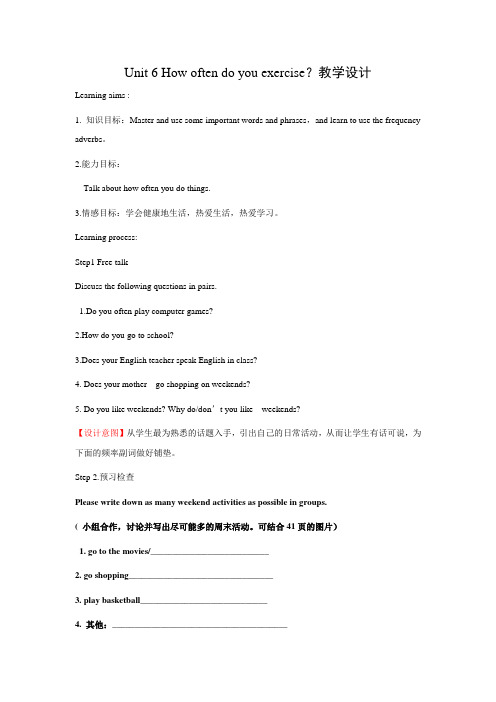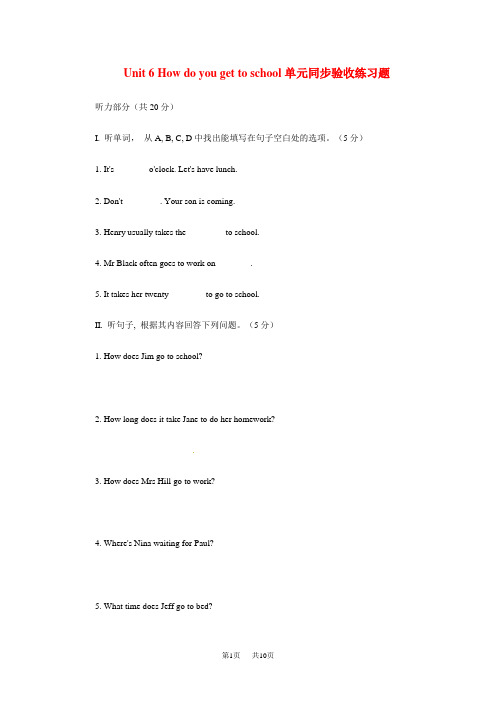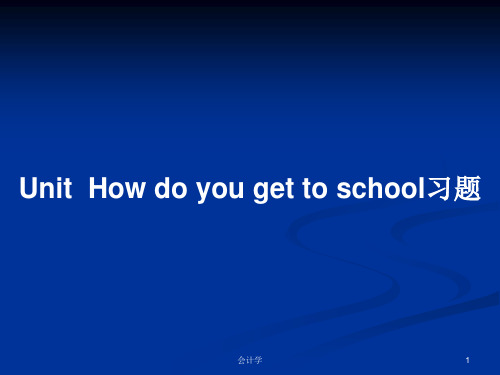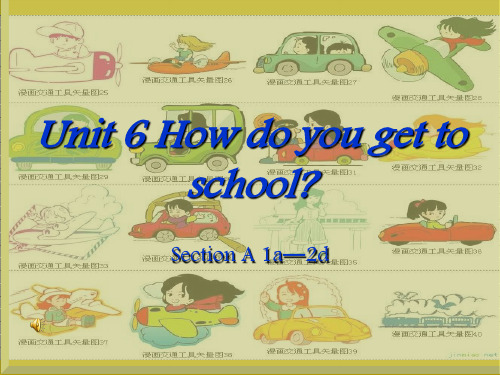七年级英语上册 Unit6 How do you get to school教案 鲁教
- 格式:pdf
- 大小:54.36 KB
- 文档页数:2

Unit 6 How often do you exercise?教学设计Learning aims :1. 知识目标:Master and use some important words and phrases,and learn to use the frequency adverbs。
2.能力目标:Talk about how often you do things.3.情感目标:学会健康地生活,热爱生活,热爱学习。
Learning process:Step1 Free talkDiscuss the following questions in pairs.1.Do you often play computer games?2.How do you go to school?3.Does your English teacher speak English in class?4. Does your mother go shopping on weekends?5. Do you like weekends? Why do/don’t you like weekends?【设计意图】从学生最为熟悉的话题入手,引出自己的日常活动,从而让学生有话可说,为下面的频率副词做好铺垫。
Step 2.预习检查Please write down as many weekend activities as possible in groups.( 小组合作,讨论并写出尽可能多的周末活动。
可结合41页的图片)1. go to the movies/___________________________2. go shopping_________________________________3. play basketball_____________________________4. 其他:________________________________________【设计意图】我校一直倡导学生自主学习习惯的培养,自主预习一直是我们培养学生自主学习的能力之一,为此我们每节课都会有一个预习检测,旨在检查学生的预习情况,同时也是督促学生预习习惯的养成,做到有布置有检查。

Unit 6 How do you get to school单元同步验收练习题听力部分(共20分)I. 听单词,从A, B, C, D中找出能填写在句子空白处的选项。
(5分)1. It's________o'clock. Let's have lunch.2. Don't ________. Your son is coming.3. Henry usually takes the ________ to school.4. Mr Black often goes to work on________.5. It takes her twenty ________to go to school.II. 听句子, 根据其内容回答下列问题。
(5分)1. How does Jim go to school?____________________________________2. How long does it take Jane to do her homework?____________________________________3. How does Mrs Hill go to work?____________________________________4. Where's Nina waiting for Paul?____________________________________5. What time does Jeff go to bed?____________________________________III. 听短文, 判断划线句子与你所听到的句子相同(S)或不同(D)。
(10分)Our school is in the center of the town. (1)But we lived in the countryside. Mum thought it was quiet there. (2)It took me an hour to go to school by bike. It was difficult for me to get to school before eight o'clock in winter if it snowed. Sometimes I was late for class. And I had to get up early in the morning. (3)I was always tired in the evening. I told my parents about it. (4)Daddy found a job in a supermarket in the town. We moved to a house there. It's not far from the train station and I can take the school bus. It takes me only fifteen minutes. (5)Now I'm not afraid to be late for school. And I can play soccer with my friends after supper.笔试部分(共80分)I. 词汇。

七年级下册英语Unit 3 How do you getto school 教案和介绍后,老师可以通过展示一些图片或视频,引导学生谈论不同的出行方式,如乘坐公交车、地铁、骑自行车、步行等。
XXX1.首先,老师可以通过展示图片或视频,教授新单词和短语,如train、bus、subway、ride、bike、sixty、XXX、eighty、y、hundred、far、minute、kilometer、new、every、every day 等。
2.然后,老师可以模拟对话,让学生研究如何用英语谈论出行方式。
例如,老师可以问学生“How do you get to school?”,学生可以回答“I ride my bike”,或者老师可以问“How does Mary get to school?”,学生可以回答“She takes the subway”。
3.接下来,老师可以教授特殊疑问句,如“How far is it from…to…”和“How long does it take?”,并且教授如何回答这些问题。
例如,当学生被问到“How far is it from your home to school?”时,学生可以回答“It's 5 kilometers”,或者当学生被问到“How long does it take to get to school?”时,学生可以回答“It takes 40 minutes”。
Ⅲ。
Practice1.老师可以让学生进行小组讨论,讨论在不同情况下应该选择哪种出行方式,并且给出理由。
2.老师可以让学生进行角色扮演,模拟在不同场景下的出行方式和对话。
3.老师可以让学生完成一些练,如填空、选择题等,以检验他们对所学知识的掌握程度。
XXX1.老师可以引导学生了解不同国家的出行方式和交通规则,让学生了解和尊重不同文化和惯。
2.老师可以教授一些有关交通安全和礼仪的知识,让学生养成良好的交通惯和安全意识。



Unit 3 How do you get to school?Section A (1a-2e)一,教学目的:1. 语言知识目的:1) 能掌握以下词汇:train, bus, subway, ride, bike, sixty, seventy, eighty, niy, hundred, far, minute, kilometer, new, every, every day,take the subway, ride a bike, by, by bike2) 能掌握以下句型:①—How do you get to school? —I ride my bike.②—How does Mary get to school? —She takes the subway.2. Talk about how to get to places (谈论出行方式)Take the bus /subway /train /taxi, ride a bike /walk.3. how引导地特殊疑问句,表示乘坐何种交通工具地方式。
how far, how long 引导地特殊疑问句。
4. 复习基数词及时间地表示方法。
2. 情感态度价值观目的:让学生感受到它们学习英语是为了在现实生活中进行交流,而不单纯是为了英语课与应付考试而学习,了解东西方国家出行方式地不同,以及不同地交通规则,教育学生注意交通安全, 加深对交通知识地了解。
倡导自觉遵守交通法规及礼貌,构建与谐地人际关系。
了解交通地发展,培养创新精神。
二,教学重难点1. 教学重点:1) how /how far /how long 引导地特殊疑问句.2) 乘坐交通工具地表示方法.3) It takes / sb some time to do sth .2. 教学难点:—How do you get to school? —I take the …/ride …/ walk…—How does Mary get to school? —She takes the subway. —How long does it take? —It takes forty minutes. —How far is it from… to…—It's… kilometers.三,教学过程Ⅰ. Warming-up and Lead in学生与老师进行简单地问候Ss : Good morning , teacher.T: Good morning, classT: Look at the picture. What can you see? Do you like your school? I usually get to school by bike, but sometimes on foot . How do you get to school?Ss 按实际情况作答S1: I ride my bike.S2: I go by bus.S3: ………T: Very good. You’re clever. Let’s learn Unit 4 Section A.之后板书: “Unit 4 How do you get to school?”Ⅱ. Presentation1. T: If you are here, but your school is in Shanghai. How do you get to school?Ss: I take the bus /plane/ boat / ship / car / taxiI ride a bike / motorbikeT: Do you know any other way?2. Teacher shows pictures on the big screen .归纳出行方式与常用短语. Ask some questions about how y ou get to…?(让学生积极主动地思考想象总结,多媒体增加趣味性,加强直观性,效果事半功倍)3. Show a picture about Part 1, on the screen.Point at girls or boys in the picture.Ask students to answer and in the blanks.S1 : How does he / she go to school?S2 : He / She … …Ⅲ. 1aT: Look at the picture on your book. Match the words with the picture. (学生们完成1a地学习任务,然后校对答案)Ⅳ. Listening 1b1. Make sure the Ss know what to do. Give them an example orally if possible.2. Read the names in the box.3. Play the tape and check the answers.Ⅴ. Pair workAsk two students to read the dialogue in the speech bubbles to theclass. Then ask students to work in pairs. Ask and answer howstudents get to school in the picture.Finally ask some pairs of students to present their conversations to the class.Ⅵ. Listening 2a1. Revise the numbers, first, zero~nine, next, ten~nieen, then, twenty,thirty, forty…finally, twenty-one, twenty-two…Teach the new word "hundred".2. Play the tape for the students to finish 2a. Then play again and check the answersⅦ. PresentationShow a picture on the TV and explain these are your home and school. Teach: home----school How long 10 minutes How far two kilometers Then make up a dialogue to practice.A: How do you to school?B: I usually take the bus.A: How far is it from your home to school?B: It's about two kilometers.A: How long does it take?B: It takes 30 minutes by busⅧ. Listening 2b1. Tell Ss the following recording is about how Tom and Jane go to school.2. First, listen to the recording fill in the first column.3. Then, play the recording for the Ss again. Ss listen and plete the restof the chart.4. Check the answers.Ⅸ. Role-play 2e1. Read the dialogue and find the answer to these questions:① How does Jane get to school?② How far is it from home to school?③ How long does it take to school from her home?2. Ss read the conversations and then find the answers to the questions.3. Check the answers with the class.4. Play the recording for the Ss to listen and repeat.5. Ss read the conversation then role-play the conversation.6. Let some pairs act out the conversation.Homework1. Remember the new words and expressions in period.2. Role-play the conversation after class.板书设计:Section A (Grammar Focus-3c)一,教学目的:1. 语言知识目的:1) 继续练习谈论出行方式take the bus /subway /train /taxi, ride a bike /walk .2)用不同方式练习 how引导地特殊疑问句,表示乘坐何种交通工具地方式。
Unit 6 How do you get to school单元过关测试笔试部分(120分)A卷(70分)Ⅰ.选择填空。
(15分)1.Which sentence is right?A.We can't get to moon by plane.B.We can't get to the moon by a plane.C.We can't get moon by air.D.We can't get to the moon by plane.2.Does __________ matter to put the things here?3.__________ your father usually go to work by car?4.Tom often __________ a kite in the park.5.__________ Lucy and Kate go to school?A.HowB.How doesC.How doD.How are6.Do you want to go there__________ or by ship?A.on the landB.on landC.by the landD.by land7.How __________ pieces of paper__________ there on the desk?A.many;isB.much;isC.many;areD.much;are8.I am not full.Could I have __________ cake?A.otherB.the other9.Tom __________ es to school late.uallyD.DON'T10.How many __________ can you see in the park?I can see__________.A.peoples;eightB.peoples;eigC.people;eightD.people;eig11.What can you see in __________ picture on the wall?I can see __________ bird.A.a;aB.the;/C.the;aD.a;the12.__________ is nice and clean.A.The air of todayB.Today airC.Today's airD.The air today13.__________ boy under the tree is an American.A.TheB.×14.How many books __________ there in your school library?15.__________ can you get there on time?By car.Ⅱ.选出与划线部分意思相近的选项。
人教版(Go for it) 七年级下册Unit3第一课时Unit 3 How do you get to school?Section A (1a-1c)一、教学目标1. 语言知识目标:掌握新单词subway、train、bus、car、boat、plane、bike等,并能熟练掌握对交通工具的提问和回答。
2. 语言技能目标:能询问他人到达某地的交通方式并转述。
3. 情感态度目标:鼓励学生学会关心别人,并学会团队合作精神。
根据实际情况选择最合理,最经济的交通方式,从小养成勤俭节约的好习惯。
二、教学重难点1. 教学重点:1) how引导的特殊疑问句.2) 乘坐交通工具的表示方法.2. 教学难点:—How do you get to school? —I take the …/ride …/ walk…—How does Mary get to school? —She takes the subway.三、学法指导1、用生动的课件调动学生进行听、说、读、写训练。
2、学习能力的培养。
通过连贯的听、说、读、写,培养学生的交际能力,发挥他们的思维能力。
四、教学过程Step one1. Learn some transportation.Look at the pictures and learn.bus; subway; train; bike; walk=on foot2.Learn more transportation:car; plane; boatStep two1.Look at a picture and make a conversation:T: How do you get to school?Ss: I ride my/ a bike to school.2.Students make more conversations about the pictures.---How do you get to school?---I take...Step three5. Show a picture about Part 1on the screen.Point at a girl or boy in the picture.Ask students to answer and write in the blanks.S1 : How does he / she go to school?S2 : He / She … …Step four3.Pair work. Make conversations---How do you get to school?---I take...---How does he get to school?---He takes the train.Step fiveHomework五、课后小结这是本单元的第一课时,主要学习和谈论交通方式,结合图片给学生以直观的印象,为学生提供语言材料。
Unit3 How do you get to school?SectionB (2a—2c)Learning objectives1. Students can remember some new words and structures in this passage and understand the passage.2. Students can use the target language to communicate in our daily life and have a clear mind-map about this passage.3. Through learning, lead students to love school, cherish their life and study hard. Key points and difficult points1) Key points: New vocabularies and some sentence patterns: village、bridge、boat 、ropeway、afraid、cross、leave、come true、between… and… It’s easy to… He is like a father to me. There is no bridge…2) Difficult points: Understand the passage and be able to form a clear mind-map of the whole passage.Teaching procedures:Step1 Warm up and lead-in1. Let’s chant2. Have a free talk: How do you go to school? How do they go to school?Step2. Pre-reading:Look at the picture and the title. Predict what the passage is about.Step3 While-reading1.Fast reading:Task 1:Read the passage quickly and answer the question:How do the students in the village go to school?_____________________________________________________________________ 2. Careful reading仔细阅读Read Para.1, finish the following tasks:Task 2:Translate the sentenceFor many students, it’s easy to get to school._____________________________________________________________________ Task 3:Answer the questionWhy do they go to school like this?_____________________________________________________________________ Read Para.2 and 3, finish the following tasksTask 4:True or false.1. Liangliang is 11 years old.2. Many of the students and villagers leave the village.Task 5:Answer the questions1. Does the boy like his school? Why?_____________________________________________________________________ 2. What’s the villagers’ dream? Do you think their dream can come true?_____________________________________________________________________3.Discussion(讨论)How can their dream come true?What can we do?What can they do?Their dream can come true if(如果) people around the world(世界各地的人们)help them.By discussing the answers of the questions, it can improve their ability of cooperation.4. Read the passage again. Complete the sentences with the words from the passage.1) For the students in the village, it is ________ to get to the school.2) They have to cross a very _____ river between their school and the village.3) They cannot go by boat because the river runs too _________.4) It is not easy to cross the river on a ropeway, but the boy is not _______.5) The students and villagers want to have a bridge. Can their dream come _____? 5. ListeningListen and repeat, try to imitate the pronunciation and intonation.Step4.Post-reading:Retell the whole passage according to the mind-map.For many students-----It’s easy to get to schoola big river between…difficult no bridge so……For the students inone small village the river runs quicklyone 11-year-old boyLiangliangis is not afraidloves schoolDream------have a bridge-----come trueRewritingComplete the passage without looking at your own books.Life is precious(宝贵的). We should cherish our good life now.(珍惜现有的生活)Step7.Homework1. For all: Finish the exercise and preview 3a and 3b.2. Optional: Write a letter to the village students and tell them the way you get to school and what you want to do for them.Unit 3 How do you get to school?学情分析Section B (2a-2c)七年级下册教材内容,较七年级上册内容比,英语知识点深入,而且我们这里的学生地处比较偏远的农村地区,各种条件相对比较落后。
笔试部分(120分)A卷(70分)Ⅰ.选择填空。
(15分)1.Which sentence is right?A.We can't get to moon by plane.B.We can't get to the moon by a plane.C.We can't get moon by air.D.We can't get to the moon by plane.2.Does __________ matter to put the things here?A.itB.thatC.thisD.he3.__________ your father usually go to work by car?A.DoB.IsC.DoesD.Are4.Tom often __________ a kite in the park.A.flyB.fliesC.is flyingD.flys5.__________ Lucy and Kate go to school?A.HowB.How doesC.How doD.How are6.Do you want to go there__________ or by ship?A.on the landB.on landC.by the landD.by land7.How __________ pieces of paper__________ there on the desk?A.many;isB.much;isC.many;areD.much;are8.I am not full.Could I have __________ cake?A.otherB.the otherC.the anotherD.another9.Tom __________ comes to school late.A.doesn'tB.likesuallyD.DON'T10.How many __________ can you see in the park?I can see__________.A.peoples;eightB.peoples;eigC.people;eightD.people;eig11.What can you see in __________ picture on the wall?I can see __________ bird.A.a;aB.the;/C.the;aD.a;the12.__________ is nice and clean.A.The air of todayB.Today airC.Today's airD.The air today13.__________ boy under the tree is an American.A.TheB.×C.AnD.A14.How many books __________ there in your school library?A.haveB.areC.hasD.is15.__________ can you get there on time?By car.A.HowB.WhereC.WhyD.WhatⅡ.选出与划线部分意思相近的选项。
Unit 6 How do you get to school?
Section A 1a ~1c
I. Teachig Aims and Demands
1. Knowledge Objects:
Key vocabulary; Target language; Oral practice.
2. Ability Objects:
Listening and writing skills; Communicative competence.
II. Teaching Key Points
Key vocabulary: walk, subway, take the subway, train, take the train, ride a bik
e,
take the bus, take a taxi, go in
a parent’s car.
III.Teaching Difficulties
Target language :
Hey, Dave. How do you get to school?
I walk. How about you , Sally?
I ride my bike.
How does Bob get to school?
He takes the train.
IV. Teaching Methods:Listening and writing methods; Pairwork.
V . Teaching Aid : A tape recorder; A projector.
VI. Teaching Procedures
Step I Greet the class and show the screen:
(This is a picture. A house o
n one side of the board and a school on the other side.
Some streets with left and right turns leading from the house to the school.) Tea
ch
the two buildings home and school.
Use finger to trace a path from the house to the school.Ask students, How do you
get t
o school? Do you walk? Do you ride a bicycle?
(For example, if you ask , How do you get to school? and a student replies, Bike,
say , Oh , you ride your bike. Class, repeat. I ride my bike. The class repeats.)
Say, Today we’re talking abo
t how you go from one place to another.
Step II Section A 1a
First ask students to look at the picture. And read the sample sentences to them.
Ask them to repeat.
Hey, Dave. How do you get to school?
I walk. How about you, Sally?
I ride my bike.
Then let students say how other students in the picture get ot school. Give them
some help if necessary. For example, take the bus ;
take the train; take the subway.
Read the phrases to them and ask them to repeat. Then ask them to write them in the
专心 爱心 用心
1
box and add other ways to get to school.
Then check the answers.
Step IV 1b
First p
oint out the names of the students in the box. Ask one student to read the
names. Now listen to the conversation. Please write the number of the name in the
white box next to the student. One of them has already been done.
Then ask students to say what each person is doing.Write the phrases on the board:
walking, taking the train, taking the subway, taking the bus.
Check the answers on the screen. Then ask the students how Bob /Mary /Paul /Yang
Lan /John gets to school?
Then, use these persons to make a dialogue like this:
A: Hey, Bob. How do you get to school?
B: I take the train. How about you, Mary?
A: I take the subway.
Ask students to complete the activity individually.Then check the answers
Step V 1c Pairwork
Ask two students to read the dialogue in the box to the class.
A: How does Bob get
to school?
B: He t
akes the train.
Now work with a partner. Make your own conversations about how the people in the
picture get to school.
Then ask students to work in pairs. Ask and answer how students get to school in
the picture..(Present their conversations to the class.)
As they talk , move around the room
, offering language or pronunciation support
as needed.
Step VI Summary and Homework
This class we’ve learnt some key vocabulary and the target language . How do you
(does he )get to school? Next class I’ll ask some students to tell me the answers.
Step VII Bl
ackboard Design
Unit 4 How do you get to school?
walk subway train
take the subway/train go in a parent’s car
How do you g
et to school? I walk.
How does he get to schllo? He walks.
Step VIII Teaching reflection:
专心 爱心 用心
2